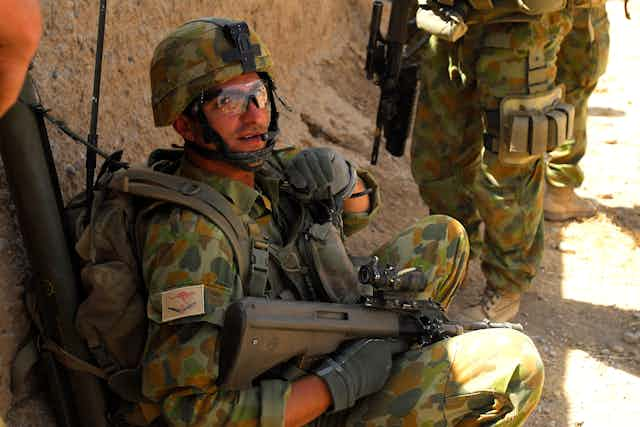In the past five or six years there has been a marked increase in the overt use of disability sport in the rehabilitation of soldiers injured in the wars in Iraq and Afghanistan – which, in a sense, is returning the Paralympics to its roots.
The Paralympic Games and its forebears – the Stoke Mandeville Games – grew out of the rehabilitation of spinally injured military personnel at Stoke Mandeville Hospital, and is now the second-largest elite multi-sport event in the world after the Olympic Games.
In recent years, we’ve seen the rise of programs such as the Paralympic Military Program and Wounded Warriors (USA), Soldiering On (Canada) and Battle Back (UK). This has recently been followed by the introduction of a program organised jointly by the Australian Paralympic Committee and the Australian Defence Force.
In some cases these soldiers are fast-tracked into that nation’s Paralympic training programs.
The proliferation of these programs appears to have come about due to a number of factors. These include:
- a rise in the number of soldiers not killed in action, but wounded to such an extent as to make returning to active duty impossible
- the media and political visibility of these wars and the veterans disabled by them, which means the military and their governments have to be visibly seen to be taking care of their needs
- the global rise in popularity and importance of disability sport in general and the Paralympic Games in particular.

Below are some of the possible reasons why the military and national paralympic committees might have decided to re-engage the link between military rehabilitation and the Paralympic movement that began nearly 70 years ago with the work of Dr Ludwig Guttmann at Stoke Mandeville.
Military motives
In 2008 Israeli researcher Michael Gross claimed the main role of military medicine is “to provide the means to ‘salvage’ significant numbers of troops and return them to duty”.
The increasing number of soldiers so seriously injured that they are unable to return to active duty, therefore, causes problems not only for the military medical system but also for the military itself.
In addition to improvements in medical knowledge issues such as the human rights agenda, disability activism, the close relationship between the military and the state they represent, the almost-saturated and immediate media coverage of conflicts and wars has forced both the military and the governments they represent to ensure individuals who are seen to have made sacrifices for their nation are well treated and looked after.

According to Coventry University researcher Sarah Green and myself, some of the possible reasons for the military to collaborate in these kinds of joint programs with their respective national Paralympic committees include:
providing a rehabilitation method that has reasonably well documented impacts upon the psychological and physical wellbeing of people with disabilities, which may in some cases lead to a soldier being able to return to active duty
the current program may provide an engaging rehabilitation method and route for injured veterans that present a challenging environment, with the potential to once more represent their nation on the world stage, albeit in the arena of sports rather than combat
to assist in keeping up morale among new recruits or those who are about to go on their first tour of duty by demonstrating that disability is not a barrier to leading a full and active life
the potential positive PR that might be accrued from demonstrating that positive steps are being taken to do all that is possible for the care and welfare of injured military veterans.
National Paralympic committee motives
According to our research, in the case of all four of the countries mentioned as having programs linking wounded veterans to disability and Paralympic sport, it appears that in every case the relevant national Paralympic committee has played a very active role in getting the program off the ground and promoting it.

Possible reasons for this include the fact these programs are a potential source of new athletes who, other than their newly acquired injuries, have strong, physically-fit bodies that are already used to enduring hours of hard training.
As with Olympic Sports in most countries, government funding for Paralympic sport in future years is often dependent upon medal success and so every national Paralympic committee in this situation is, therefore, always on the lookout for the next Paralympic star or at least a new method of finding them in order to secure the future funding upon which everyone’s livelihoods depends.

Finally, media interest in the military is usually quite high, so programs such as these provide an excellent opportunity to promote and raise awareness of disability and Paralympic sport within a particular country.
The historical link between military casualties and the development of disability and Paralympic sport has become somewhat lost in the mists of time as the Paralympic Games have developed and broadened to include civilians with disabilities.
But the growing acknowledgement of the impact of sports participation upon the psychological and physical wellbeing of people with disabilities and the increasing number of soldiers severely injured in battle have conspired to renew this link.
It is possibly somewhat ironic then that the Paralympic movement and its athlete pool is being partly refreshed from the ranks of the military to whom it owes its very existence.

